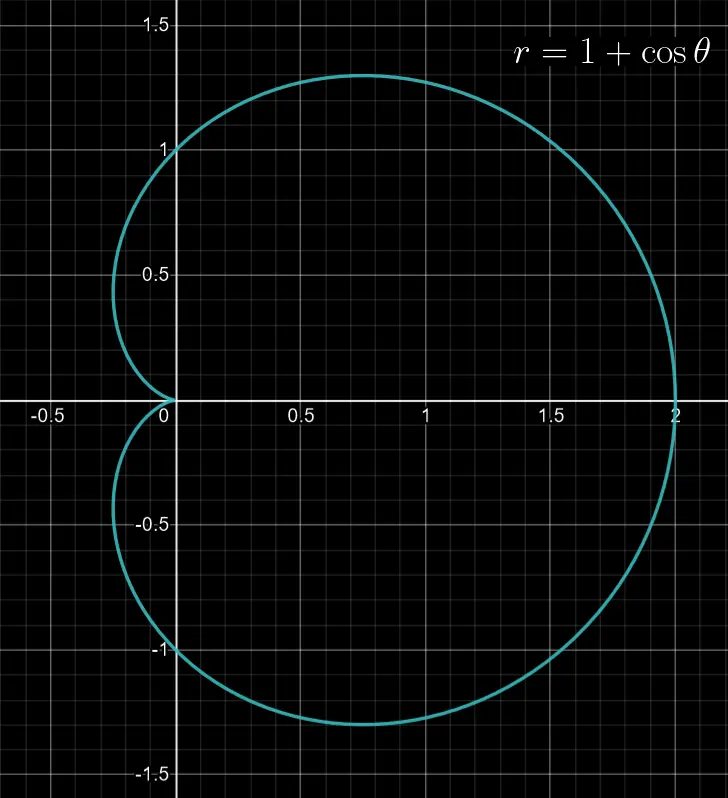题目
计算二重积分 $\iint_{D} xy d \sigma$, 其中,区域 $D$ 由曲线 $r=1+\cos \theta$ $(0 \leqslant \theta \leqslant \pi)$ 与极轴围成。
解析
题目中给出的曲线 $r=1+\cos \theta$ 其实就是著名的心形曲线,该曲线的准确形状如图 01 所示(在做题时,没有画出该曲线形状的必要):

由于 $0 \leqslant \theta \leqslant \pi$, 因此,上述曲线与极轴所围成的区域 $D$ 其实就是该曲线位于图 01 中 $x$ 轴上半部分的曲线与 $x$ 轴所围成的区域。
此外,对于极坐标系下的二重积分计算问题,我们可以通过把极坐标方程转换成直角坐标方程的方式,达到将极坐标系下二重积分的计算问题转换成直角坐标系下二重积分的计算问题。
但是,在本题中,我们并不能将极坐标方程 $r=1+\cos \theta$ 转换成一个相对简洁的直角坐标方程:
$$
\left\{\begin{matrix}
r = x^{2}+y^{2};\\
x = r \cos \theta;\\
y = r \sin \theta.
\end{matrix}\right.
\Rightarrow
$$
$$
r = 1 + \cos \theta \Rightarrow
$$
$$
x^{2} + y^{2} = \sqrt{x^{2} + y^{2}} + x.
$$
于是,在本题中,我们就直接在极坐标系下计算该二重积分,过程如下:
$$
\iint_{D} xy d \sigma \Rightarrow
$$
$$
\iint_{D} r \cos \theta \cdot r \sin \theta \cdot r d r d \theta \Rightarrow
$$
$$
\int_{0}^{\pi} \cos \theta \cdot \sin \theta d \theta \int_{0}^{1+\cos \theta} r^{3} dr \Rightarrow
$$
注:
[1]. 在极坐标系中,代表极径的变量 $r$ 默认都是大于或等于 $0$ 的。
$$
\frac{1}{4} \int_{0}^{\pi} (1+\cos \theta)^{4} \cos \theta \sin \theta d \theta \Rightarrow
$$
$$
(-\frac{1}{4}) \int_{0}^{\pi} (1 + \cos \theta)^{4} \cos \theta d(\cos \theta).
$$
接着,设 $\cos \theta = A$, 由于 $0 \leqslant \theta \leqslant \pi$, 而且,当 $\theta = 0$ 时,$\cos \theta = 1$, 当 $\theta = \pi$ 时,$\cos \theta = -1$, 因此:
$$
1 \geqslant A \geqslant -1.
$$
即:
$$
(-\frac{1}{4}) \int_{0}^{\pi} (1 + \cos \theta)^{4} \cos \theta d(\cos \theta) \Rightarrow
$$
$$
(-\frac{1}{4}) \int_{1}^{-1} (1+A)^{4} A dA \Rightarrow
$$
$$
\frac{1}{4} \int_{-1}^{1} (1+A)^{4} A dA \Rightarrow
$$
注:
[1]. 在使用换元积分法时,一定要注意积分上下限的变化方式,例如本题中积分上下限的变化过程:$\int_{0}^{\pi} \rightarrow \int_{1}^{-1} \rightarrow \int_{-1}^{1}$.
[2]. 由于在手写时,变量 “$t$” 与加号 “$+$” 极易混淆,因此,在本题中,我们是令 $\cos \theta = A$, 而不是以惯常的方式,令 $\cos \theta = t$.
$$
\frac{1}{4} \int_{-1}^{1} (A + 4A^{2} + 6A^{3} + 4A^{4} + A^{5}) dA \Rightarrow
$$
注:
[1]. 由于上式的积分上下限 “$\int_{-1}^{1}$” 是关于原点对称的,且 $A$, $6A^{3}$, $A^{5}$ 都可看作奇函数,因此,这些奇函数的积分结果都是零。
$$
\frac{1}{4} \int_{-1}^{1} (4A^{2} + 4A^{4}) dA \Rightarrow
$$
$$
\int_{-1}^{1} (A^{2} + A^{4}) dA \Rightarrow
$$
$$
2 \int_{0}^{1} (A^{2} + A^{4}) dA \Rightarrow
$$
$$
2 \cdot \frac{8}{15} = \frac{16}{15}.
$$